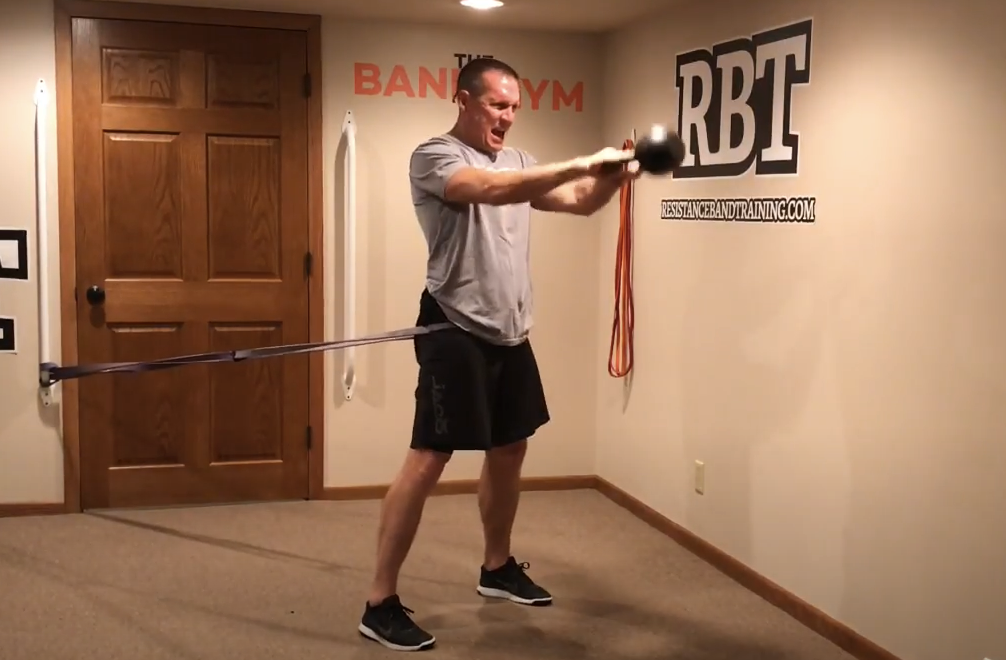Resistance band training remains a unique training approach that can easily create questions, concerns and a feeling of being overwhelmed.
This makes perfect sense since 90% of what is written about strength training focuses on the use of free weights and machines. When I first started training with flat bands in 1996, I was a weight-lifting gym rat. Therefore, I had the same questions and concerns I suspect many of you have.
However, over the years it has become very apparent through training 1000’s of fitness adults that band training has significant benefits. It also has some specific limitations when compared to its free weight counterpart.
The Next Step
While training with bands for almost 20 years, I can assure you I have thought through every exercise, workout and training approach I have shared. I do this to make sure what I share with you has been proven and time tested. I don’t make up content to sell you a band.
No question, over the years I have changed my opinion and approaches on how I train with flat continuously looped layered bands. However, in looking back overall, many of the same principles, techniques and recommendations still hold true.
If you’re not changing, the likelihood is you’re not getting better.
Like any training device, there are resistance band training pros and cons. I want to address these resistance band training pros and cons in hopes of helping clear up some of the questions, concerns, misunderstandings, myths and confusion you may have about resistance band training. I’ll also address how it compares to free weight training.
However, before I have you dive into reading this article, lets review several general understandings. I want to make sure we’re all on the same page when it comes to what I mean by resistance band training.
General Resistance Band Training Understandings
- Resistance band training is about training with flat continuously looped layered bands. Not tubes, bungee cords, molded flat bands or braided elastic bands.
- Resistance bands are not dumbbells or barbells. They are not made of iron and can be damaged or broken if not used properly.
- All bands, like many products, are not created equal. There are low quality and high quality manufactured flat bands. Quantum Bands are my choice because they are 100% latex, layered (not molded) and are manufactured using a latex bonding process with the application of latex welded to eliminate layers peeling apart.
- I am passionate about resistance band training but I am not advocating training with bands only. Instead, my goal is to convince you that they need to be a consistent part of your training program on an every-workout basis.
- Resistance band training is not designed to simply replicate free weight exercises. It allows you to create unique exercise options unmatched by free weights that are important to building a body that not only looks good but more importantly feels and moves great.
After reading this article, YES, I hope you will consider testing out Quantum Bands. However, I’m perfectly fine if you don’t. My goal is simply to help improve your knowledge about why resistance band training (not Quantum Bands specifically) should be a significant part of your weekly training routine along with traditional free weight devices if you enjoy training with weights.
Resistance Band Training Pros
1. Train Anywhere
Obviously resistance bands are very light-weight which makes them extremely portable. However, when combining this unmatched portability with an unlimited resistance potential and the ability to apply this resistance along multiple force vectors (while performing any movement), it makes the portability advantage of “Training Anywhere and Anytime” even more significant.
2. It’s a Low-Cost Training Investment
Next to body-weight training, which is FREE, resistance band training is easily the most cost-effective form of resistance training. This is especially true when you take into consideration the unlimited exercise options and the ability to impact all aspects of fitness and performance training.
To emphasize this point, realize it would mean purchasing 9 pairs of dumbbells ($200+) to create the same resistance variability that one pair of red small bands (10 to 50 lbs) can create at $22 a pair.
3. Provides a Unique Resistance You Can’t Get from Weights
Resistance bands create what is referred to as a “variable ascending resistance.” This is significantly different than a free weight’s constant resistance. First of all, a variable ascending resistance increases as movement range of motion increases. This means it will increase work output throughout the full range of motion.
Second, a variable ascending resistance causes a higher degree of end-range stabilization. This happens to be where stabilization is needed the most to help in preventing joint-related injury.
Last, a variable ascending resistance allows movement velocity to accelerate which is exactly the training stimulus needed to increase power. As a result, bands teach the body how to accelerate force. This, in turn, enhances power production—something we all use every day in life not just sports.
Best Way to Start Training with Resistance Bands
4. Is Joint Friendly
Repeated joint compression and lack of joint stabilization is what ultimately breaks down joint surfaces. This leads to arthritic conditions. Resistance bands create significantly less joint compression because they are not gravity dependent like free weights.
Therefore, bands can strength train muscles using horizontal and rotational forces with far less joint compression. Also, unlike free weights and machines that must follow a specific pattern of movement, bands allow you to train muscles using unlimited patterns of movement. This, in turn, creates a far more joint-friendly training experience.
5. Trains all Aspects of Fitness and Performance
Bands allow you to have one training tool that is portable enough to go anywhere and be able to train all aspects of fitness and performance including…
- Flexibility
- Muscle Strength
- Muscle Growth
- Power
- Cardio
- Core
- Fat Loss
- Mobility
- Balance
- Coordination
- Agility
- Speed
- Quickness
A resistance band’s light-weight construction and variable resistance allows it to be applied to the body in multiple ways. That, in turn, allows for a wide variety of training objectives to be addressed effectively.
6. Trains Movements not Muscles
Resistance band training is not a tool designed to only replicate free weight movements. Instead, it is a tool that can replicate any functional movement while applying an unloading, movement retraining assistance or a loading strength enhancing, muscle building resistance. As a result, resistance band training will make movements, not just muscles, stronger while simultaneously improving muscle coordination and integration.
7. Makes Exercise Creativity Endless
Resistance band portability and unique resistance capability, along with the ability to apply resistance to any movement the body can perform, provides the user with an endless variety of exercise options. Along with this variety, bands also provide a high level of training versatility. This opens up the opportunity for a tremendous amount of individual exercise creativity.
8. NO Excuse Training
The #1 key to achieving solid training results comes down to consistency of workouts and eliminating workout obstacles. Resistance bands are defined by their ability to provide great workouts that can accommodate Anybody, Anywhere, Anytime, while training Any Movement at Any Intensity. This essentially eliminates 90% of the reasons that come with why workouts are missed.
9. Challenges Core Stability and Joint Mobility on Every Movement
Resistance band training is a system designed to train the body as a complete kinetic chain versus individual segments. As a result, 90% of all exercises require simultaneous activity of the lower and upper body. This means the core is involved on every rep.
Being elastic means there is a driving force encouraging greater range of motion on every concentric reach, lunge, squat or step. This means muscles are constantly being asked to stabilize and lengthen throughout an entire workout.
10. Provides Resistance to All Movements
Bands provide resistance to all movements. This includes complex multi-joint and multi-muscle movements like running, jumping, walking and crawling. Being able to apply resistance to these types of complex functional movements gives individuals the opportunity to train cardio and strength simultaneously.
It also allows you to enhance all the components that come with performing complex movements. This includes coordination, balance, agility and rhythm.
11. Applies Progressions and Regressions Instantly
Progressing or regressing with bands is as simple as changing up the level of starting tension in the band. This can occur by stepping back or forward on attached or partner attached training and changing up band size on attachment free training.
Along with that, you can always change speed of movement or incorporate a corresponding secondary movement that compliments the primary movement. An example of this is adding a simple step with a horizontal pull or push.
Resistance Band Training Cons
1. Not the Best at Offsetting the Effects of Gravity
Gravity is a key driver of function along with momentum and ground reaction forces. Band resistance can influence gravity but free weight resistance is definitely a more effective developer of gravity-based vertical plane strength. Since gravity is not going away, staying strong against gravity is a key to maintaining a solid functional strength longevity.
2. Bands Can Break
- Resistance bands are not made of iron.
- Layered flat bands are 300 times more durable than flat molded or tubular bands.
- Each 41-inch Quantum Band can safely stretch 2 yards.
- Over 99% of the bands we replace are damaged due to user error.
Learn more by reading – Why Bands Break
These are important facts to reinforce the point that, yes, bands can break. However, training error and poor quality manufacturing is the primary reason they break. Plus, comparing tubes to flat bands is like comparing apples to oranges. Also, making sure flat bands are layered not molded is an important key to band durability.
For those bands that last for years, it comes down to proper recommended application of training and consistent band care.
3. Difficult to Quantify and Measure Gains
Flat band resistance is a variable resistance that is dictated by length of stretch, width of band and thickness of band. As a result, it is difficult to quantify exact poundage of resistance. For those that train with exact numbers, resistance band training can be frustrating.
4. Difficult to Reflect Back on Training Progress
Along with not being able to quantify band resistance, it also becomes challenging to reflect back on previous training levels to determine progress. Very often, progress with resistance band training is measured on how individuals are performing with day-to-day activities, recreational activities or how their strength changes when attempting to lift a dead weight.
However, progress can also be measured by the ability to return back to strength training after having to discontinue due to joint injury or pain.
5. Difficult to Build a lot of Muscle Mass
Free weight training for muscle hypertrophy has been well documented and proven to work. Band resistance has also shown muscle hypertrophy gains. However, not to the degree that free weights have. Even though resistance bands can create muscle hypertrophy, free weight training remains the most research-based catalyst toward achieving efficient muscle hypertrophy.
Portrayal of Resistance Band Training in Fitness Communities
Now that we have a better understanding about resistance band training pros and cons, I want to discuss a few problems that exist on how resistance band training is being portrayed in the fitness and performance training community.
Bands Are for Toning
Resistance band training has for years been looked upon as a way to “tone muscles” or rehabilitate injuries. This may be the case when using tubular devices and thera-band. However, it is definitely not the case when it comes to training with flat continuously looped layered bands.
Unfortunately, if you Google resistance bands you will find more about tubular bands than flat bands with no differentiation in training discussed between the two types of bands. Therefore, flat resistance bands are grouped with tubular bands which is like saying barbells and kettlebells are the same thing.
It is because of this lack of differentiation with tubular bands that flat bands are looked upon as primarily a low resistance muscle toning device.
Why Not Both
Muscles are reactors and adapters to stimuli that challenges them. That challenge can come in the form of free weight resistance, band resistance or learning a complex movement like throwing or running. The difference lies in what adaptations or responses occur when the stimulus is repeatedly attempted or applied.
Knowing bands create significantly different (not better) responses than free weights, it would make sense to train with both versus relying solely on one form of resistance.
Unfortunately, free weights remain the standard for strength training when it comes to what is being discussed and demonstrated. Yet it is obvious that free weights cannot match the responses and adaptations resistance bands can create.
Bands Are the Last Alternative to Strength Training
For years, bands have been considered the last alternative to strength training. Yet in the world of power-lifting, flat bands (not tubes) have become a key training tool used alone or in conjunction with complex free weight training routines. To me, that indicates that flat bands provide a training effect that free weights can’t.
It has and will continue to be my opinion that resistance bands need to be part (not exclusively) of every training program. This is because of their unique impact on muscle strength, power and function.
How Do I Get Started Correctly?
It doesn’t have to be all or nothing. Start implementing bands into your existing training program by substituting in band exercises. From there, continue to add in exercises until you feel you have mastered a series of exercises you could now put together in a complete resistance band only workout.
This is the first step in GETTING YOU BODY BETTER with BANDS!
Summary
Clearly there are resistance band training pros and cons. Resistance band training can train your body to look, feel and move its best by providing a training stimulus that fits how the body was designed to work. It is obvious that these training effects cannot be replicated training with free weights alone.
However, by eliminating exclusivity and instead combining elastic “variable ascending” band resistance with “constant” free weight resistance”, you provide the body with exactly what it needs to achieve a higher level of performance, fitness and function.
The Fastest Way to Get Better With Bands is by Joining a Community of Like-minded individuals and Being Coached by the World’s Leading Expert
Both are Available as a Member of The Band Gym
Take a Virtual Tour







